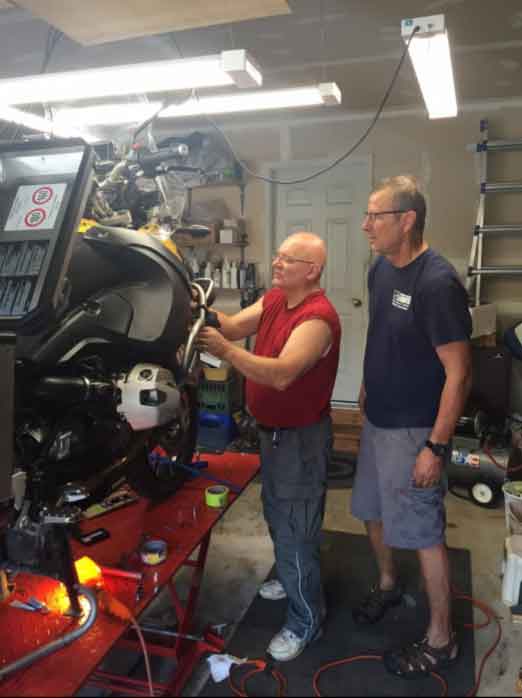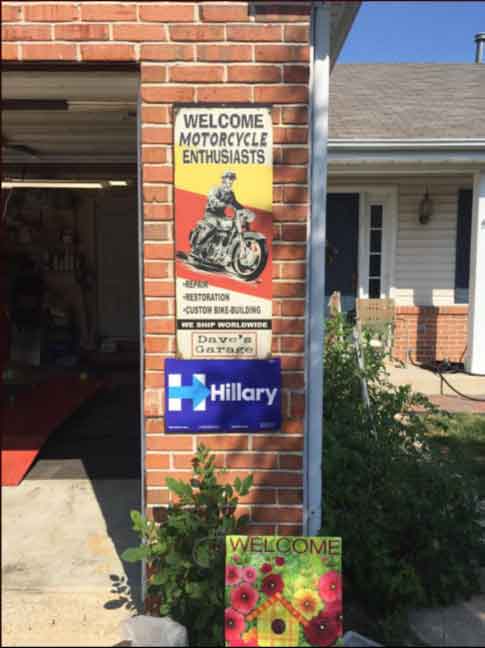
Dave’s Garage opened up for the Fall Tech Session on September 24th. Eight club members attended and performed various tasks. Rich Leslie arrived first and wanted to check synchronization of the throttle bodies on this oilhead. He was kind enough to have removed the fairings from his RT which made the job a lot easier. We installed the twin–max vacuum tool which checks the vacuum on each throttle body. No adjustment was necessary as the vacuum was the same on each side during idle and at higher engine revolutions.
As we were finishing up, Phil Schoulberg arrived. Phil wanted to replace the alternator belt on his new 1200 GS. I checked the flat rate book, “remove belt cover, remove belt, install belt, replace the cover.” This should take about ½ hour. Now before he gets to that Phil had to remove the engine guard/crash bars. Rich offered his services (right). An hour or so later they were ready to remove the belt cover. The new belt went on without a problem. It was now time to reinstall the crash bar assembly.
During this time other members showed up and helped themselves to “coffee and.” I was helping our new member Don Faber balance the carbs on his older airhead. He first wanted to install a new diaphragm on one of the carbs. When he finished we balanced the carbs and then used the spoke method (to perform this test you attach a short motorcycle spoke with its nipple to the spark plug.
The thread of the nipple is the same size as the end of the spark-plug. Reinstall the spark-plug wire. By placing a screwdriver across the spoke and the cylinder head you short out the plug on that side.) You short out one cylinder in an attempt to set the mixture on the other.
Like many of the older bikes Don’s was idling on one cylinder. If you short out one cylinder and the bike dies, it’s only running on that cylinder. We spent a fair amount of time trying to get both cylinders firing at idle. It was left at a runnable but not perfect balance. I think the carbs need a good cleaning. To that end I now have an ultrasonic parts cleaner that does a great job of cleaning out the small bleed ports on these Bing carbs.

In the meantime, Jim Shaw fired up the GS911 and reset his maintenance schedule on his bike. Dave Anderson wanted to install a remote positive battery connection on his wife’s new bike. On this model you have to remove the tank cover to get at the battery in case you want to jump start the engine. The bike already had a remote charger connection.
We located some wire and the required terminal ends and proceeded to install the connection. As usual the battery terminals had so many extra connections we had to find a few longer bolts to assure a proper connection. George Siede was also doing some electrical work on this bike but I did not get involved in this work.
A few folks left and it was getting close to lunch time. Phil suggested a BBQ restaurant just down Highway 141 from my house and we took a lunch break. Jay Green returned home with me as he wanted to install a new Fuzeblock on his bike. This was the second generation design which improved on the connection for the 12 volt input. I fought an electrical problem with my GPS connection for a few days, weeks ago. I replaced all the wire and connectors but the power to the unit was still intermittent.
I finally tracked the problem down to a crack in the printed circuit board at the 12 volt in-put on my old style Fuzeblock. It was this bad connection that was causing problem. I was happy to see that the manufacturer corrected this defect. Jay and I worked to find a good location for the fuse block and its associated relay. We connected the necessary wiring with the required terminals and called it a day. All in all we had a successful gathering and I enjoyed the company of all. GR
